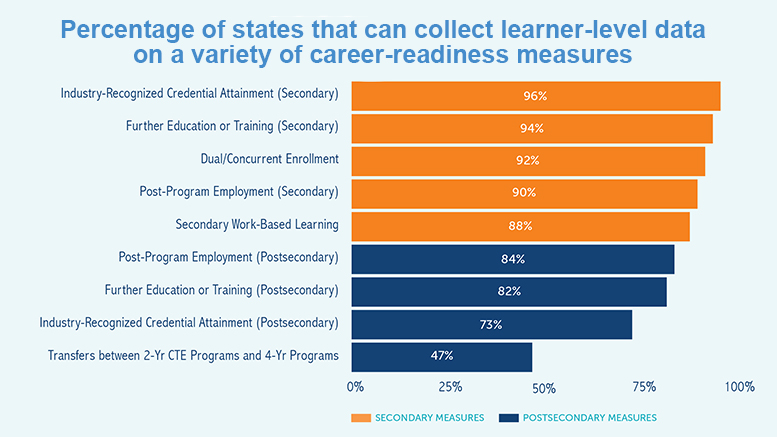State career and technical education (CTE) directors don’t have enough reliable data to make meaningful programmatic and policy decisions, according to a report from Advance CTE.
About half (49 percent) of state CTE directors have enough confidence in their data systems to give them the information they need for high-stakes decision-making about secondary and postsecondary CTE, the report says. Ninety percent of state directors, however, believe improving state CTE data systems is a top priority, says Advance CTE, a nonprofit that represents state leaders responsible for secondary, postsecondary and adult CTE programs.
Data systems not aligned
In major findings from the study:
- States often use CTE and career readiness data for low-stakes decisions, such as informing technical assistance, but are less likely to use data to influence funding and decisions to transform or phase out CTE programs.
- CTE data systems are not sufficiently aligned across the secondary, postsecondary and workforce sectors. Only 28 percent of state directors say their CTE data system is “mostly” or “fully” aligned with postsecondary data systems, and just 18 percent say their CTE data system is aligned with workforce data systems.
- Many states rely on self-reported measures of career readiness and do not often use rigorous validation processes. Only about a third of states use student surveys to measure entry into the workforce or continued education and training for postsecondary program completers.
A few bright spots
Despite the current challenges, the report finds some states have developed innovative ways to collect and validate their data. In one example, the University of Hawaii Community Colleges System partnered with five other agencies and organizations to establish the Data Exchange Partnership covering secondary, postsecondary and workforce data. Each of the agencies has created agreements to share and match learner-level data, and Hawaii even used some of its federal Perkins funds to hire a full-time employee to manage its state CTE data. The Data Exchange Partnership allows state leaders to evaluate economic outcomes for learners who exit the postsecondary sector.
In another example, Iowa has established working relationships across the secondary education sector, community colleges and the state workforce agency, enabling state leaders to access learner-level outcomes data for post-program placement, employment and wages. One reason Iowa has been so effective at measuring learner outcomes is that both the secondary and postsecondary sectors use the same unique identifiers for individuals in the public education system, the report states.
Similarly, the Iowa Department of Education, through its community college management information system and its relationship with the Iowa Workforce Development agency, uses Social Security numbers as unique identifiers to measure education and learner outcomes.
The report finds that 45 percent of states have an agreement with the state labor department or other agency to collect post-program employment data, and 41 percent of states are partnering with the National Student Clearinghouse to identify learners who continue their postsecondary education or training at another program or institution.
Perkins will help
The recently reauthorized Strengthening Career and Technical Education for the 21st Century Act (Perkins V) gives states a platform for improving their data quality and effectiveness, according to Advance CTE.
“CTE has a unique position at the intersection of secondary and postsecondary education and the workforce. It is critical for state leaders to work together to effectively use and improve their data systems to make more informed decisions about CTE program quality and equity in order to serve each learner in their community,” Kimberly Green, executive director of Advance CTE, said in a press release.
“Right now, states have the opportunity to improve data quality and effectiveness through Perkins V,” Green said. “We look forward to working with state leaders as they examine their data collection practices, establish cross-sector data sharing partnerships, and embed data-driven decision-making throughout policy and practice.”

